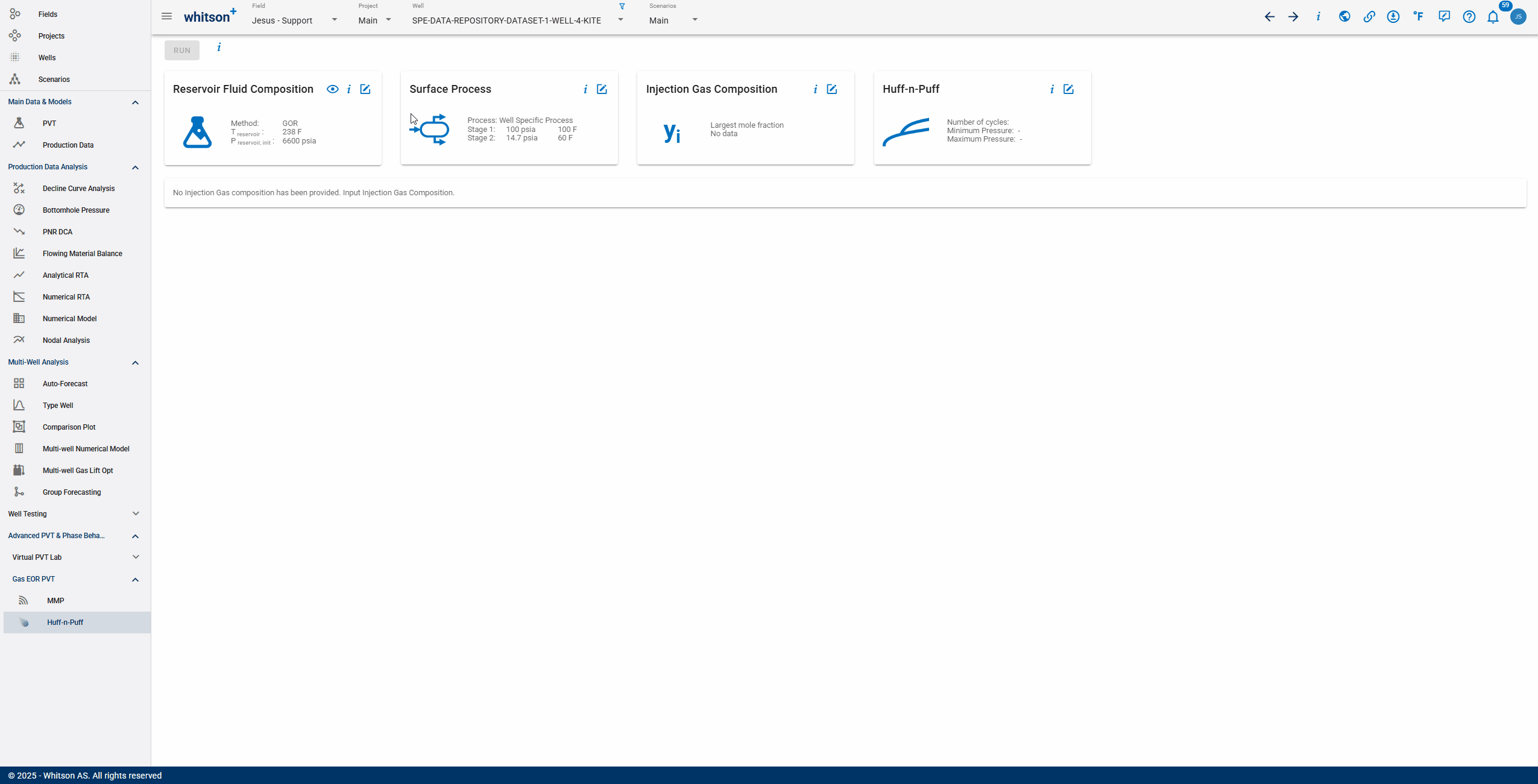Gas Huff-n-Puff PVT Experiment
The gas Huff-n-Puff (HnP) PVT experiment is a hybrid of the Constant Volume Injection (CVI) experiment (isovolume swell test) and the Constant Volume Depletion (CVD) experiment repeated in several times (cycles). Read more about the PVT experiments here.
1. Generating a HUff-n-Puff Calculation
In this module, the gas Huff-n-Puff (HnP) PVT experiment is simulated. The module quantifies a set of key performance indicators, such as cumulative EOR efficiency and recovery factor, from the following input data:

-
Reservoir Fluid Composition:
- Choose an Initial reservoir fluid composition (generated with any of the available methods)
- Input an initial reservoir pressure
- Input a Reservoir temperature
-
Surface Process:
- Edit the surface process associated to the well (used to generate the black oil table)
-
Injection gas composition:
- Input injection gas composition for each relevant component
-
Huff-n-Puff:
- Number of Huff-n-Puff Cycles
- Maximum and minimum cycling pressure
2. Terminology
2.1. Recovery Factor (\(RF_o\))
The recovery factor of surface oil, \(RF_o\), is defined as the cumulative produced oil (\(N_p\)) divided by the original oil in place (\(N\)), i.e. \(RF_o\) = \(N_p\) / \(N\). The produced surface oil is calculated by processing the removed amounts through the wells associated surface process. As the number of cycles increase and the amount if will converge to 100%
2.2. Cumulative EOR Efficiency
EOR efficiency (E) is defined as the "incremental STB / Sm3" produced per "MMscf / Sm3E6" gas injected, i.e. E = \(N_{p}\) / \(Q_{inj}\). This is a key output from running the gas HnP PVT experiment, as it quantifies the "uplift per cost".
2.3. Saturation Pressure
The saturation pressure, and how it changes with cycle, communicates something fundamental about the gas Huff-n-Puff process. When producing at pressure above the saturation pressure, the mix of reservoir fluid and injection gas is single-phase (a pure dillution process = salt-water/freshwater mixing), which is associated with the highest efficiency (=mixing). When procuding at pressure below the saturation pressure, the mix of reservoir fluid and injection gas is two-phase, which is associated with the lowest efficiency (=vaporization). Hence, understanding how the saturation pressure is changing with cycle, and time, is fundamental to understand the efficiency of a specific gas HnP scheme.
2.4. Relative mixing uplift
Production above the saturation pressure is mixing dominated, and incremental production is due to volume increase ("swelling"). Production below the saturation pressure is vaporization driven. During the production (puff) period of a HnP cycle, the depletion from the maximum pressure to saturation pressure will have "max" recovery efficiency (pure-mixing salt-fresh water analogy). The subsequent steps below the saturation pressure are less efficient and calculated by differencing total cycle recovery minus “mixing” recovery down to the saturation pressure. The relative mixing uplift each cycle is calculated as \(N_{p,mixing}\)/\(N_{p,total}\).